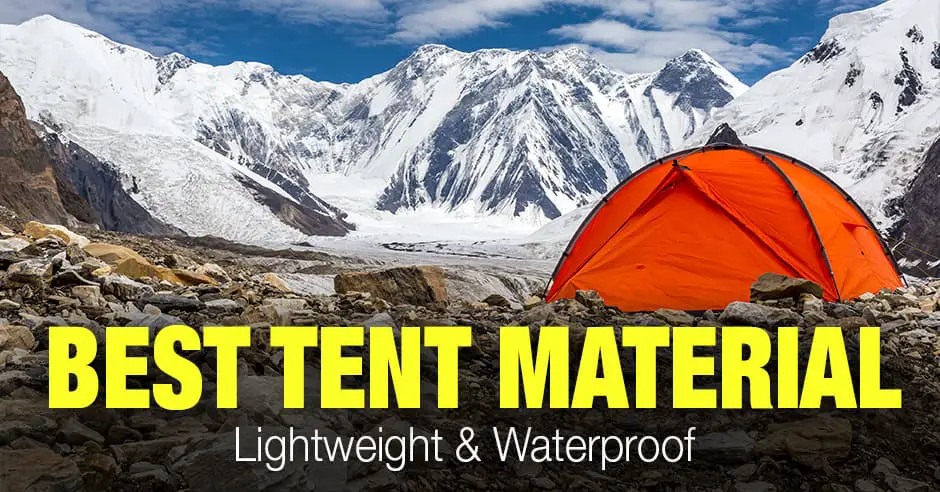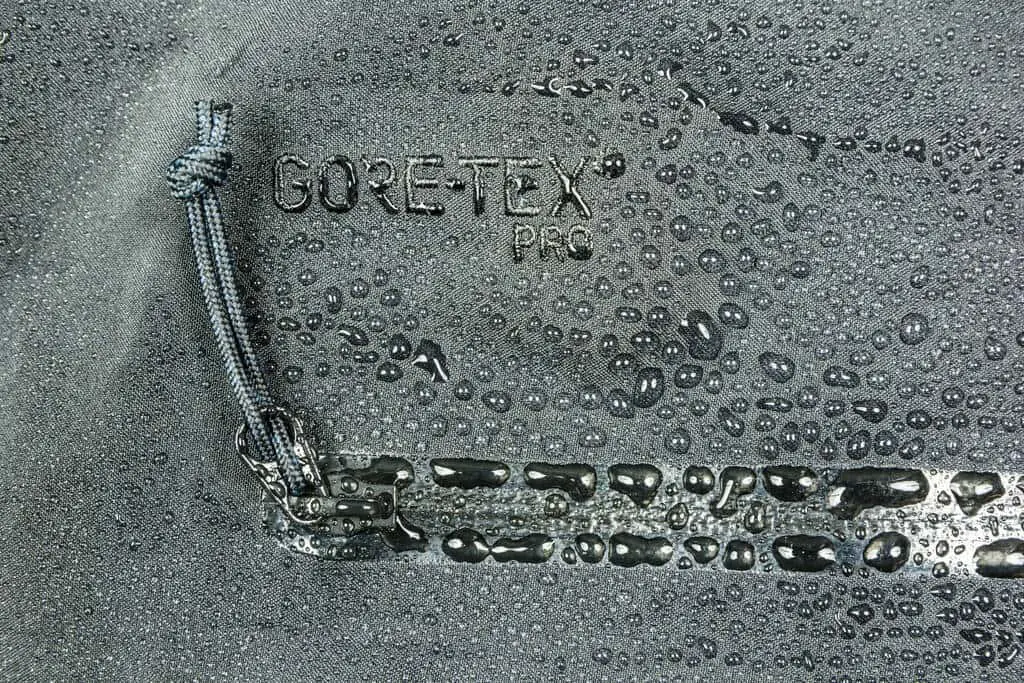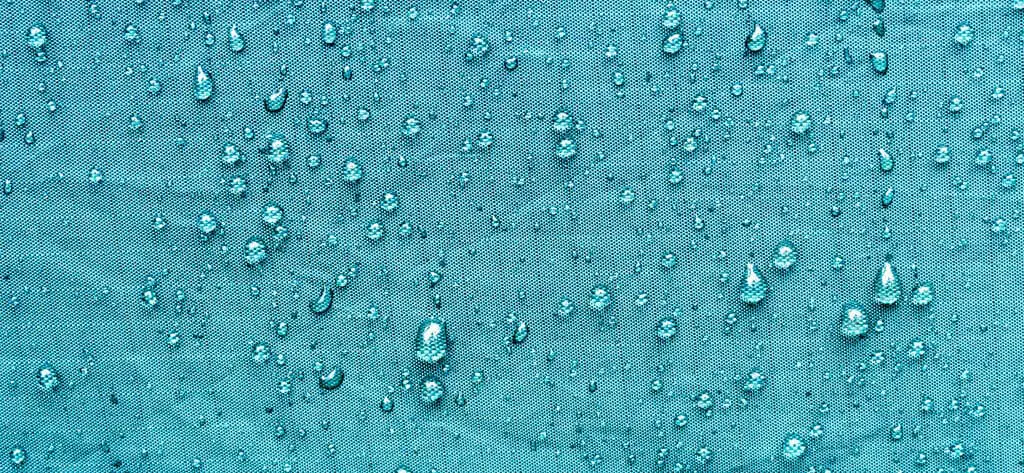Tent material is one of the most crucial factors to consider when buying your first tent. There are many options of materials which can become a little confusing for the first-time tent buyer, especially when you don’t know what the characteristics of the materials are and the benefits and downsides of each one.
The best lightweight waterproof tent material is nylon coated with a waterproofing layer of silicone and with the seams of the tent sealed with silicone. This tent material will serve the greater requirements of most camping tents, being lightweight, waterproof, and cheap. Regular extreme cold weather camping may require a more expensive material for insulation.

The type of tent material you choose will largely be determined by your needs and what you want to use the tent for. If you are simply camping and you drive with your car to the campsite, then your tent needs would be different than if you are out hiking on a mountain trail.
What Are The Available Tent Materials?
There are many different types of tent materials, and each manufacturer gives its own spin on why its tents are the best. The actual plain truth of the matter is that there is no one magic all-purpose perfect tent material that is suitable for all occasions.
When you select a tent, you need to know what you will be using it for and what conditions the tent will need to handle to keep you sheltered for your adventure in the outdoors.
If we examine the materials that tents are being made from, you can establish which material will most suit your needs and make a tent selection based on this knowledge.

Canvas Tent Material
Canvas or cotton is actually a great material for a tent, but only for a tent with a particular purpose. Canvas, if treated properly, is waterproof, breathable, and a good insulator. These attributes make it a great tent material.
Before a canvas tent reaches its full waterproofing capability, it needs to undergo a weathering process, which is basically being exposed to the elements and rain. This makes the fibers swell and lock together, improving their waterproofing ability. Canvas tents may need to be weathered every few years to retain their waterproof characteristics.
The downside is that canvas is heavy and bulky, and you will not be able to fold it into a small, compact, easy to carry package. Canvas tents are great for tents that are transported by vehicle and for tents that will be set up long term on a site for a more semi-permanent shelter.

Polyester Tents
Polyester is a lightweight material that has similar properties to nylon. It is fairly durable but not as strong as nylon. It is water-resistant but not waterproof, so many tent manufacturers who use this material will coat it with another material such as silicone, polyurethane, or a blend of these two materials.
Polyester does not breathe well, which will result in the formation of condensation on the inside of the tent overnight from the moisture in your breath. This problem can be relieved by having adequate ventilation in the tent.
Polyester is a flammable material, so it is dangerous to use an open flame in this type of tent or locate it near a campfire.
The type of coating used on the polyester material can increase the price of the tent. Polyester has similar characteristics to nylon but is more expensive than nylon, especially if an expensive coating is used. So if you have a constrained budget, nylon would be a better choice.

Poly-Cotton Tents
Poly-cotton or poly-canvas is a blend material using canvas or cotton mixed with polyester. This makes the material a little lighter than canvas and improves its resistance to mildew, but it significantly increases these tents’ price tag.
These tents will usually have a waterproof coating, which will make the fabric not only waterproof but water repellant. These tents are very durable, but their bulkiness, weight, and price tag normally deter weekend campers from tents of this material.
Nylon Tents
Nylon is a synthetic material that many people mistakenly consider to be waterproof. Nylon is not waterproof; water will soak into the material and eventually come through the nylon material.
The benefit of nylon for camping is that it is extremely lightweight and cheap, making tents made from this material very affordable. Nylon is cheaper than polyester, which is why nylon is the most popular material for lightweight tents.
Nylon is also a stronger and more durable material than polyester, but polyester has the edge over nylon in its resistance to UV damage. Coatings are often added to nylon tents to improve their resistance to UV damage.
Unless coated with another material, tents made from nylon will not be waterproof. For this reason, many hiking tents that are made from nylon will be coated with either silicone, polyurethane, or sometimes a blend of the two.
Nylon is a flammable material, so no open flames should be used in the tent, and it should be placed well away from a campfire.
Nylon is not a great insulator, so for cold weather, such as camping in the snow, this type of lightweight tent material does not offer much heat retention.

Polyethylene Tents
Polyethylene is a type of plastic that is similar in characteristics to polyurethane and nylon. It is a durable, water-resistant material, but like the other two, it needs a coating to make it a waterproof tent material.
The downside to polyethylene is that it is heavier than nylon and polyurethane, and it is a poor insulator, which makes it not great for colder climates.
Gore-Tex
Gore-Tex is another modern fabric that makes for a very lightweight tent material that is also waterproof and breathable. Gore-Tex is a proprietary product made from expanded PTFE and is famed for its all-weather use.
While this is a great material for making tents, it is extremely expensive, and it is therefore usually only used by mountaineers that will be overnighting on the frozen slopes of a mountain top. The ones made from Gore-Tex are, therefore, normally solo or, at the most, two-person tents.

Vapex
Vapex is another synthetic tent material that is sometimes used for tents, but it is not a common material used for tents. Vapex is waterproof and breathable, which eliminates the condensation issue on the inside of the tent.
Vapex is an excellent insulator and is fire resistant, which is why it is mostly used for the application of making tents for extreme cold camping, such as winter camping in Alaska.
The material is made from a special type of polyurethane, which is hydrophilic and gives it waterproof but breathable characteristics.
This tent material, although lightweight and waterproof, is very expensive and is therefore not recommended for the casual camper unless you go camping in extremely cold conditions.
Dyneema
Dyneema is actually a brand that makes lightweight, waterproof tent material from a material called cuben fiber. This is a very strong material, stronger than nylon and any of the poly fabrics. Dyneema is also extremely lightweight and is used to manufacture many different hiking and backpacking items such as backpacks and tarps.
This material does not stretch, and the elasticity is not affected by moisture, which makes it great for tents and tarps. The problem with using this material for a tent is that it is not breathable. You will therefore get condensation on the inside of the tent unless you have good ventilation.
When used to make tents, it is often used in combination with polyester material to create a hybrid, lightweight, and waterproof tent material.
The main downside of Dyneema is that it is very expensive, and there are much cheaper lightweight tent materials such as nylon, which can be treated to make it a waterproof tent material.
The price of this material puts it out of the reach of most general campers.
What Is Ripstop?
Ripstop is a way of laying down the material in a pattern that gives the material a better resistance to ripping. Most tent materials, including canvas, can be produced in a woven, layering manner, giving them additional strength and preventing small tears in the material from ripping easily.
There are many materials that are marketed as ripstop or look like ripstop but are simply made with a pattern that looks like ripstop but actually adds no benefit to the material.
Best Waterproof Tent Material
Most nylon and polyester tents will have a waterproof coating that is either silicone-based, polyurethane-based, or a blend of the two. The seams can also be taped or sealed to waterproof the tent.
Between silicone and polyurethane, the silicone coating is the better coating since it not only adds waterproofing but also increases the strength of the material. Polyurethane is also not completely waterproof; the water will eventually soak through the coating and the material.

Polyurethane also degrades over time, especially after long periods of storage and produces an unpleasant odor, and begins to peel off. In this regard to waterproof tent material, silicone is the better choice.
The third option is a blend of silicone and polyurethane, which is cheaper, but allows the best qualities of both materials to make an acceptable, more affordable waterproof tent material.
Seam taping is normally done on heavier material tents and on polyethylene tent materials. Seam sealing is used more frequently on lightweight tent materials with a silicone waterproof treatment.
Best Lightweight Tent Material
The best lightweight tent material for most general-purpose camping is, without a doubt, nylon. Preferably nylon that is coated with a silicone waterproofing material to strengthen the nylon and add the necessary waterproofing to the material.
Modern nylon materials are very lightweight, and expensive nylon is still substantially cheaper than some of the other specialty products such as Vapex, Dyneema, or Gore-Tex.
This makes nylon the best material for most outdoor tent applications and why it is the most commonly used material for lightweight tent material.
Best Lightweight Waterproof Tent Material | Conclusion
Considering all the factors, a nylon tent fabric coated with a silicone or poly-silicone blend waterproof coating is the best value for money lightweight and waterproof tent material.
Extreme cold temperature camping is a different scenario and will require a more specialist, expensive material for a suitable tent.






